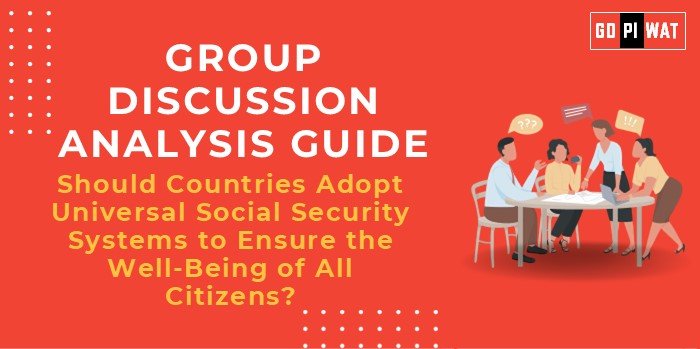📋 Group Discussion (GD) Analysis Guide
Should Countries Adopt Universal Social Security Systems to Ensure the Well-Being of All Citizens?
🌐 Introduction to Universal Social Security
Opening Context: Universal social security is gaining global attention as governments aim to reduce inequality and enhance citizen welfare. Its importance is magnified in the wake of economic challenges, such as those seen during the COVID-19 pandemic, which exposed vulnerabilities in existing social safety nets.
Topic Background: Universal social security encompasses programs that provide income support, healthcare, and essential services to all citizens. Rooted in the ideals of social justice, countries like Norway and Germany have long embraced such systems, with recent debates around their feasibility for developing nations like India and Brazil.
📊 Quick Facts and Key Statistics
- Global Social Security Coverage: Only 46% of the world population is covered by at least one form of social protection (ILO, 2022).
- India’s Social Spending: 2.6% of GDP, compared to Norway’s 14% (World Bank, 2023).
- Impact of Universal Basic Income (UBI) Trials: Finland’s UBI pilot showed improved well-being and modest employment outcomes (2017-2018).
- Poverty Reduction Potential: Universal systems could halve poverty rates globally (UNDP, 2022).
🏛️ Stakeholders and Their Roles
- Governments: Design and implement universal programs.
- International Organizations: Provide financial and technical assistance (e.g., ILO, IMF).
- Private Sector: Collaborate on funding and execution, particularly in developing economies.
- Citizens: Demand accountability and participate in decision-making.
✅ Achievements and Challenges
- Achievements:
- Norway: Reduced income inequality through comprehensive social security.
- Finland: Enhanced mental health in UBI trial participants.
- Brazil: Bolsa Família program lifted millions out of poverty.
- Challenges:
- High fiscal costs in low-income nations.
- Risk of inefficiency and corruption in implementation.
- Debate over the potential disincentive to work.
🌍 Global Comparisons
- Success: Norway’s cradle-to-grave system ensures universal healthcare and pensions.
- Challenges: South Africa’s struggle with funding and inefficiencies in social grants.
📚 Case Studies
- India: PM-KISAN, a targeted income support scheme, covers millions but lacks universality.
- Kenya: Mobile money-based cash transfers have proven effective in reaching remote populations.
🗣️ Structured Arguments for Discussion
- Supporting Stance: “Universal social security fosters equality and safeguards against economic shocks. Norway’s model has successfully reduced inequality and enhanced societal trust.”
- Opposing Stance: “High fiscal burden and implementation challenges hinder feasibility. In low-income countries, the resources for universal systems are often unavailable.”
- Balanced Perspective: “Universal systems are ideal but require phased implementation and strong governance.”
📈 Effective Discussion Approaches
- Opening Approaches:
- Present global statistics: “With only 46% of the global population covered by social protection, universal systems are a pressing need.”
- Use a contrast approach: “While Norway provides universal healthcare, most developing nations lack basic safety nets.”
- Counter-Argument Handling:
- “High fiscal costs can be mitigated through international aid and efficient targeting.”
- “The risk of disincentivizing work can be addressed with partial, conditional transfers.”
🔍 Strategic Analysis of Strengths and Weaknesses
- Strengths: Reduces inequality, provides economic security during crises.
- Weaknesses: High cost, risk of inefficiency.
- Opportunities: Leverage technology for efficient delivery, build global partnerships for funding.
- Threats: Political resistance, macroeconomic instability.
🎓 Connecting with B-School Applications
- Real-World Applications: Link to policy analysis and economic projects. Explore cross-country implementation strategies in case studies.
- Sample Interview Questions:
- “What lessons can India learn from Norway’s universal social security system?”
- “How can technology bridge gaps in delivering universal social security?”
- Insights for Students:
- Analyze trade-offs between universality and fiscal sustainability.
- Study pilot projects like UBI for practical learning.


